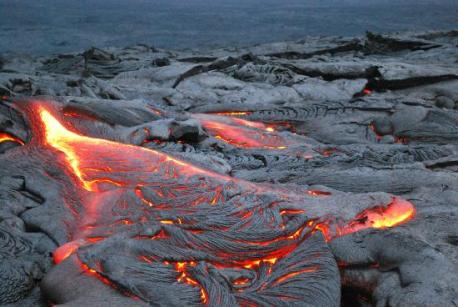
As Judith [1], an older family friend, and I get to the edge of the lava flow at Puʻu ʻŌʻō, a vent on Kīlauea, one of Hawaii’s active volcanos, she heads just past the “safe zone” the ranger’s set up. I freak out. I’m a Freshman in high school and Judith reminds me of this. I remind her of the pit of boiling lava that is visible through the cracks in the ground, under our feet. I think my argument wins here.
As we head down, Judith’s legs start to give out. We didn’t bring flashlights and it’s getting dark. She thinks if she just goes faster it will be ok. This doesn’t work. She heads to a rock, again off the ranger marked path. I remind her that the path is where the earth’s crust is supposed to be think enough to support our weight. She sits down on it and starts to cry.
“Just leave me here!” Judith, a smart, strong, and powerful woman in many ways, isn’t that great at self care, this was unfortunately encouraged in women, of her generation.
“We’ll just wait, until you feel like walking again.”
“But I’m night blind! I won’t be able to see soon!”
“Well I’ll be able to see and I can guide you.” I’m lying. I am also night blind. I’ve told Judith this. I’m hoping she doesn’t remember. My plan is to get back to the path and hope the makers are visible, with the light from the lava. At least, if we stopped and waited there, the stuff we would be sitting on was less likely to suddenly explode or worse implode. That was also where someone would come looking for us.
Once, I disappeared in a crowed for a few minutes. My parents called the police. They’re were waiting at the bottom. When it actually got dark and if we were not back yet, I was sure someone would be called. We didn’t bring cell phones [2].
We actually start climbing down and I realize I can’t see anything, but Judith is so freaked out that I don’t know how to tell her. New plan: I test the ground before each step and if it seems solid I take a step, then if I don’t fall in and nothing exploes, Judith will know it’s ok. In my teenage mind, I was convinced that I had to act like I knew what I was doing or Judith would go wandering off into the darkness and fall through.
We made it down ok. I had no idea where the path was, but the car was far enough away, that I knew we weren’t on it. As we drove back, we got to the forrest area, near the entrance to Volcano National park. On the side of the rode, I saw an old woman looking out at me. She smiled and then seemed to merge with the trees. I decided that this was Pele, the Hawaiian goddess of volcanos, in her old woman form. She was letting us know just who let us get down safely (in retrospect the rangers probably expect this kind of thing to happen and the area on either side of the path is probably also safe. I still wouldn’t test it).
My Family’s Visit’s to Hawai’i
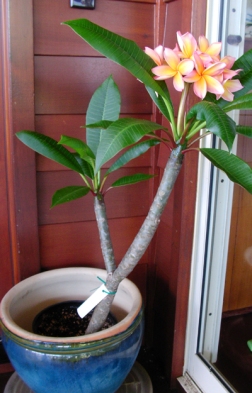
In the 80s my parents bought timeshare at a condo exchange in Puerto Vallarta. I’ve never been there. By the time I was born my parents the condo exchange had expanded into a company with properties all around the world. One near Punalu’u beach on the big island of Hawaii has been a favorite in my family. The area is relatively remote, compared to the big tourist areas like Hilo and Kona.
When my parents would mention the trips to one of our hippie liberal friends we would hear something like: “Why would you go there? It’s all manufactured tourist stuff!” This always confused me.
The location of the area of we visit means that we spend a lot of time at farmer’s markets and just talking with people. Hawaiian culture is completely unique. To an outsider, it seems open, accepting, and sincere.
We still keep in touch with one family we met on one of our first trips. Once we were there for Easter and this family invited us to their Easter brunch, even though they hadn’t seen us in 10 years. We felt like it would be rude to accept, but the family insisted.
On another trip, at a Farmers market, I started talking to the singer in a band that was playing there: Aunti Lani and we stayed in touch all the time that I was in high school. This is, of course a simplification, as all outside observations must be. My point is the resorts aren’t Hawaii, any more than Hollywood is California [3].
Sharing Cultures
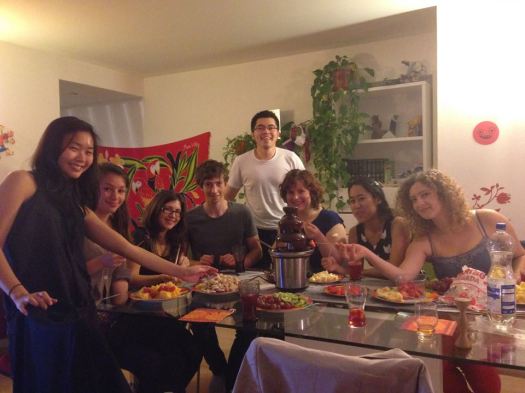
When I came home this Christmas my mother gave me a box of Hawaiian sweet bread mix from the Punalu’u bakery to share with my friends here in Europe. My friends often host parties with foods from their home countries. I had thought to bring the bread to one of these events, where we’re normally pretty nonchalant about mixing cultures: we had french croissants at the event our Italian friends did & Italian Tiramisu, when my Mexican friends cooked.
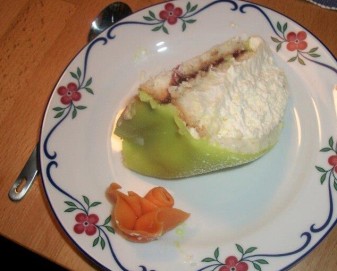
However, Hawaiian sweet bread never seemed to go with what people were cooking. Meanwhile, as a Southern Californian, most of what I consider “my cultural food” is actually americanized Asian, Mexican, and Spanish food, with some Italian (Pizza) and German (Hamburgers). Last fall I did Thanksgiving and after that I ran out of ideas.
Most of my ancestors are Swedish, but I’ve only spent 7 days in Sweden and don’t know how to cook anything authentically Swedish (except Princess Cake). In the current context, it would feel kind of fake, anyway.
I’m not European?
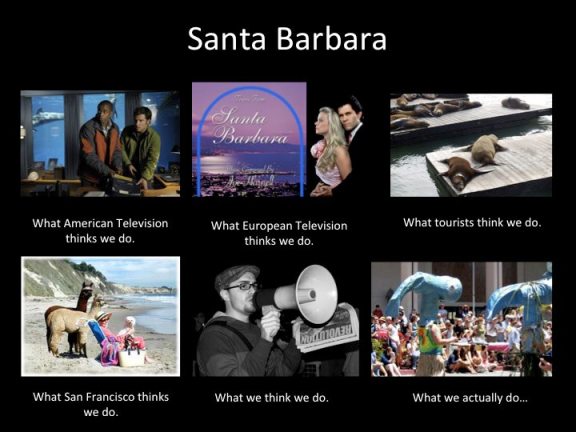
At a bar in France, a man asks if I’m one of those “exotic” Americans. “Huh?” “I mean where are you from?” he presses. “Uh, California.” “No, like where did your people come from, before you were American?” I look down at my vampire pale skin and the bright pink 50’s style dress I’m wearing. Exotic? I wonder if there’s been a mistake. “Uh…I’m not sure exactly, mostly Sweden, Ireland, Scotland, I think Norway, Poland…” he stops me excitedly “so you are one of those exotic ones! You’re from everywhere!” I give him a what-the-f*ck look. I just named a bunch of places in Europe: so clearly not “everywhere”.
In general, here ideas about diversity and otherness in cultural and ethnic identities are different. Here, countries that now make up the EU may have been bitter enemies for hundreds of years, as their boundaries remained fluid. The idea of Pan-European identity is new and it certainly was not around when “my people” last lived in Europe. In France, an anti-EU, anti-euro, anti-immigration, party just took over the government. Though, many people in France are not happy about this.
It’s interesting in a context where vaguely European means exotic. Here, as an american of (mostly) [4] European decent, I’m not sure what my “American” culture even means. Individualism is American. There are also Native American cultures, but these were systematically annihilated. The reservation system also means that modern Native American cultures are isolated and Native Americans are often absent in “American melting pot ” culture, except in ways that don’t involve the participation and consent of Native American people and that are often quite offensive.
Then there are the Hawaiian people or Kanaka Maoli, Polynesians who came to Hawai’i between the 4rd and 9th century AD. As the rulers of an independent kingdom, with the second Hawaiian renaissance in the 1970s, and since there was no Hawaiian genocide (“just” cultural oppression and exploitation), the Hawaiian people are an exception in that their culture is relatively well preserved. You can see aspects of it all through out modern Hawai’i. However, it has also been commandeered by corporations and organizations in Hawaii and this is the version of Hawaii most mainlanders are familiar with (hence the confusion of our liberal friends).
I thought a Hawai’i party might work, both because the relatively intact native culture makes it unique and because my families travels have allowed me personal experiences and memories in Hawai’i. I’m educated enough to know that it could go wrong. As an outsider, it’s often hard to see what is offensive and harmful. In disability activism, this is a familiar concept. Often what seems empowering to someone who does not live with a disability, is rather offensive.
What Appropriation is and What’s Wrong with it
In high school, I used to go as a goddess for Halloween. The last one I did was Parvati transforming into Kali [5]. In college, a Pagan friend pointed out that this was sexulizing and exotifying other’s religions. You could argue that I wasn’t sexualizing them, but I knew one of the things I liked about the goddesses is that they were often sexual, in a way that was also threatening and empowering. I decided that I would stop with the goddesses, until I had the guts to do a sexy Jesus costume. That never happened and I’ve since realized why this “equal opportunity” approach, isn’t actually equal.
Appropriation is the use of another culture in ways that are offensive or otherwise detrimental to that culture. Issues with appropriation include: perpetuating harmful stereotypes, theft of cultural knowledge, & misuse of cultural items or images that have special meaning. I am going to focus on stereotypes, because I did my undergraduate thesis on stereotypes ( disability, to be precise) and they are the main reason I’m passionate about the topic of appropriation. Stereotypes may be a type of heuristic, a go to assumption. Weather they are or not, thinking of them as heuristics, can help illustrate why they are dangerous.
Think of hubristic as a wikipedia articles. They allow you to know most of what you need to know about things quickly. Most of the time they are reliable, but then there are those poorly sourced articles, where the information isn’t good. Maybe you look up “this-idea-about-a-people” and there are no citations. You know it’s not good. You know you need citations, but unless people actually take the time to rewrite it, it’s still there and it’s still the page everyone sees, whenever anyone looks up “this-idea-about-a-people” they still see that page. Maybe you’ve done you’re own research and looked up and read good relabel sources, but when you need a quick information on “this-idea-about-a-people”, you don’t have time to look for those good sources you found that one. You’re going to go to wikipedia.
Behaviorally, this is kind of how stereotypes work, except they’re even more harmful. They shape how we act and make choices. This is true even if we are the ones harmed by them. If you chose to interact with any aspect of any culture, other than your own or the dominant culture in your country, and you do not address stereotypes (i.e. give people alternative information), you risk interacting with them. Here is the scary part: in brains, these types of interactions may increase the probability that they will occur again in a less another context context.
Appropriation vs Education: Can I do that?

I knew doing this right would be hard and I felt extra pressure to get it right, because of my experiences in Hawaii, Hawaiian culture and the mysterious woman on the road, when we were coming back from the volcano. She was probably just trees. However, according to the stories, Pele isn’t one of those goddesses, you mess with. She might not appreciate a misrepresentation of Hawai’i or Hawaiian people. I figured it’s better not to take chances.
I decided focus on my actual experiences in Hawai’i rather than the Hawaiian people and culture. I deliberately called it a “Modern Hawai’i Feast”, rather than a “Hawaiian meal/ party/ etc.” or “luau”. From there I came up with a menu of asian-Hawaiian fusion foods:
- Sweet Bread
- Huli Huli Chicken (blended fresh pineapple, instead of pineapple juice, sans white wine, because the cost to flavor addition doesn’t work out for me there, & worchester sauce, because I couldn’t find it).
- Macadamia nut crusted fish (used the shrimp recipe, but replaced shrimp, with fish)
- Vegetarian Poke (replace ahi, with tofu)
- Sticky rice (thinking of plate lunches)
- Fruit salad (mango, pineapple, kiwis, and strawberries, with lime juice dressing)
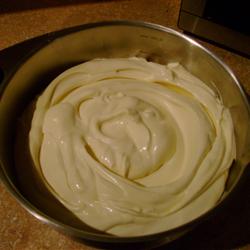
Desert:
- Coconut mochi (Daifuku Mochi, add coconut milk instead of water, replace cornstarch with shredded coconut; I didn’t fill them with anything, but red bean paste would work)
- Brazilian passion fruit moose (passion fruit/ Liliko’i is the only thing that is Hawai’i thing here, I just found some fresh ones in the supermarket and this was the only recipe I could find where the amount of passion fruit used was right for the amount I could buy)
Drinks:
- POG
- Pina Coladas, which aren’t Hawaiian, but the ingredients for Blue Hawaiians, which were invented in Hawaii, are too expensive! Found out the hard way that pineapple juice is better than blended fresh pineapple here.
If you want an alternative to tiki cocktails: There are Hawaiian breweries and wineries that ship to the mainland. Kona coffee and Kona coffee liquors are also a good option.
Going with a “Modern” theme in a place like Hawaii where the modern culture is highly influenced by appropriation of local customs by the tourist industry, could easily be a copout to do anything and everything. On the, “if you’re not part of the solution, you’re part of the problem” theory, I decided to put some boundaries to avoid misrepresentation and asked people to avoid dressing up (no one wanted to anyway). I also decided that it was important to try include elements that were as close to Native Hawaiian culture, as possible, since one of the biggest problems Hawaiians have is recognition. A friend expressed an interest in leis, so I got some ribbons to make ribbon “ribbon ti leaf” leis . To the menu I added:
- Oven Kalua pork (since I didn’t have liquid smoke I used Chipotle chili), which is traditionally cooked in an underground pit called an imu.
- Oven baked sweet potatoes, which the Polynesians brought to Hawaii. I just them left wrapped in tinfoil, to keep them warm
On music, I decided to mix modern interpretations of traditional chants, with modern artists like IZ (Israel Kamakawiwo’ole), Amy Hānaialiʻi Gilliom, and traditional chanting by Kumu Hula Pilialohaokalani Christiansen, along with some Jack Johnson. “E ala E”, the first track on an IZ’s album of that same name, directly addresses issues of colonialism. His music is beautiful and having it in the background seemed like a friendly way to introduce issues relevant to many Native Hawaiians.
I discussed the history of Hawaiian cultural appropriation, in the invitation:
“ON RESPECT FOR LIVING CULTURES: I intentionally called this a modern feast, because it is not a representation of the Hawaiian people, but of modern Hawaii, which predominately incorporates aspects from Hawaiian culture, South East asian cultures, and European cultures. Not long ago, Hawaiians were banned from practicing their own culture, which is now repackaged and stereotyped for profit, often without their consent or participation. I am not Hawaiian and I have no right to “share” their culture with you. Rather I am sharing things from my experiences with friends and family, in the US state of Hawaii.”
I don’t know enough about the Hawaiian Nationalist movements to have much of an opinion about it. My first instinct is to say that while I agree that usurping authority from the Kingdom of Hawaii was wrong (and illegal), I’m wary of breaking up modern communities over past disputes and I do find the idea of race based Nationhood troubling. Apart from setting a dangerous legal precedent, fights for equality, in Hawaii, are not limited to Native Hawaiians, and the Hawaiian Kings played an active role in early immigration efforts. This said, in a rather quick search of Hawaiian Nationalist websites there seems to be a lot of different ideas and one thing I read on environmental protection and land conservation sounded pretty cool!
Something I couldn’t do, but I would have liked to is purchase things from Native Hawaiians to make sure they benefit financially from their cultural knowledge. I do this with Native American products and when it comes to Native American tribes and Canadian First peoples this is really easy . In fact, in a great demonstration of exactly the exact right way to respond to appropriation criticism, LA designer Paul Frank teemed up with Native American artists to create a great line of appropriate Native American styled products. Buying from Native Hawaiians is more difficult. The best solution I can think of is to buy products made in Hawaii, where about 23% of the population identified as Hawaiian in the 2000 census.
How it Went

It ended up being a subdued event. While 15 people originally RSVPed, a bunch of people canceled, day of, because they decided to study. I had to throw out a lot of food (which I hate). Then it took longer than I thought it would to finish cooking. Thankfully no one was interested in leis (both because there was no time and I did not buy enough ribbon. Suggestion, count on one roll, in each color, per guest). Just as we got everything set up it started to rain, so two friends picked up either side of the table and started to cary it inside as another friend and I grabbed all the breakable items.
People loved the food. Particular favorites included the fish, the POG, the sweet potatoes, the chicken, & the moose. The rice and pork were not finished, but I got those in bulk, when I thought 15 people were coming! I got asked a lot of questions about where it came from:
“Is this authentic?” “That’s hard to say. The Kingdom of Hawaii lasted until the 19th contrary and the culture of the people of Hawaii is integrated into the rest of modern Hawaiian culture, with all of it’s international influences. I can tell you that the pork and the sweet potatoes are the closest to foods, prior to European contact.”
1.Name and identifying details changed. 2.Last time, we could see the lava flow from the road. We didn't think it was going to be a long hike. 3. Seriously guys, except for the Getty, you can probably skip L.A. and it will be ok. If you must: do Pasadena, Santa Monica, & then Miracle Mile, before Hollywood. If you really want to "experience" LA get a book, head to Union Station, which is stunning on its own, and just sit there for an hour or two. I don't know what you'll see. It might be a bunch of Japanese tourists walking next to a punk rock band or it might be a line of drag queens headed to a Christmas party or a guy with a guitar who is making up a new song for each person he sees. You'll see all kinds of people, whose appearance would draw a stares, in other parts of the world, just doing their thing, while all around everyone else does their thing. Do bring a book. 4.The genetic test my Dad got also said Persian, which would be Iran, but Iran didn't exist when my "people" lived there. 5.I had a thing for very specific costumes that no one else would understand.

I just saw this and I wish I had it when I was trying to come up with “American Food”. It’s a list of 50 Thanksgiving dishes, one for each state. Some aren’t really “Thanksgiving-ey” IMHO, but maybe they are in those states. We definitely don’t have kale and date stuffing at my parent’s house in California. What’s really great is the overview of cuisine in each state: http://www.nytimes.com/interactive/2014/11/18/dining/thanksgiving-recipes-across-the-united-states.html?_r=0
LikeLike
For more accurate information on what people actually eat for thanksgiving try these results from google searches. While we’ve never made persimmon bread, I’ve had it and my family does bbq the turkey: http://www.nytimes.com/interactive/2014/11/25/upshot/thanksgiving-recipes-googled-in-every-state.html?abt=0002&abg=0
LikeLike